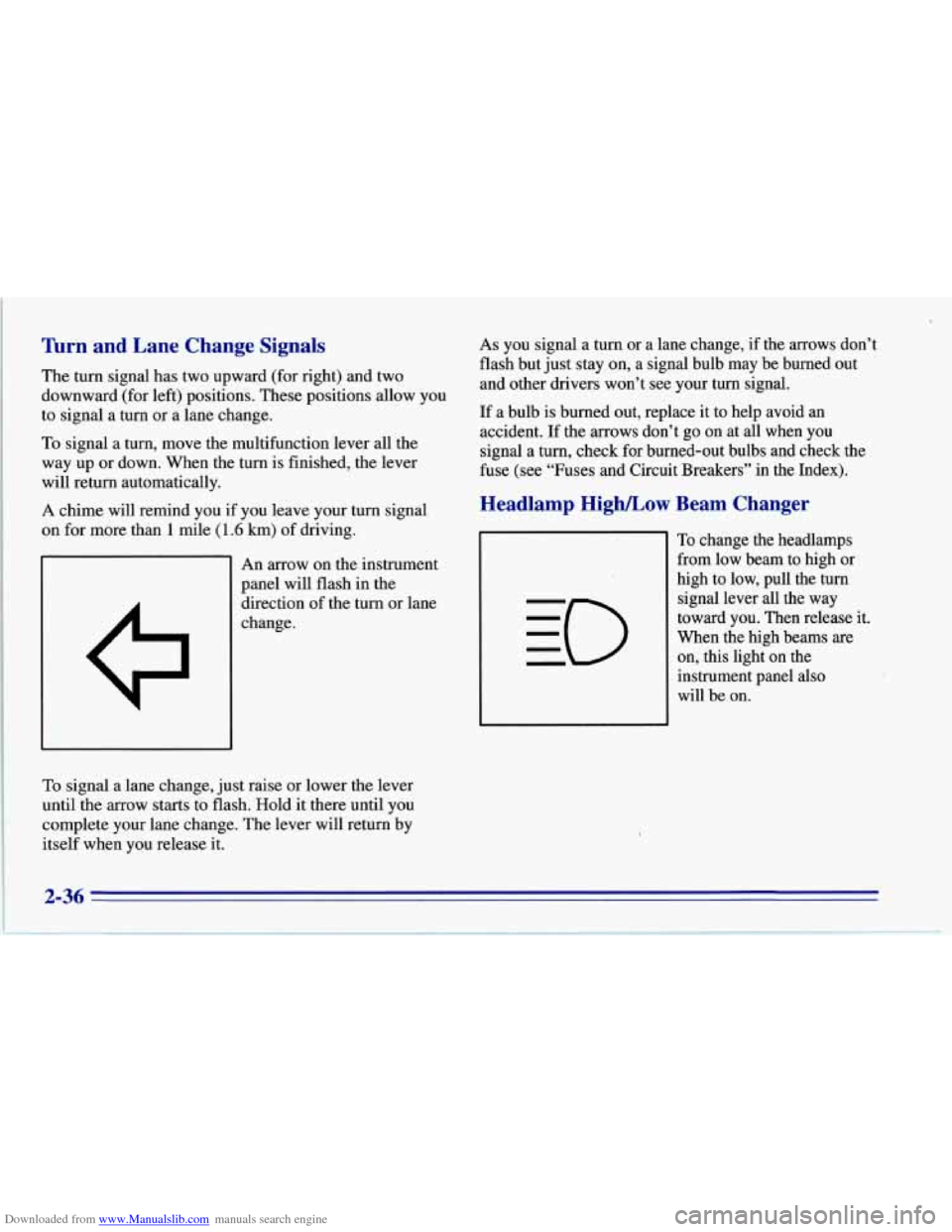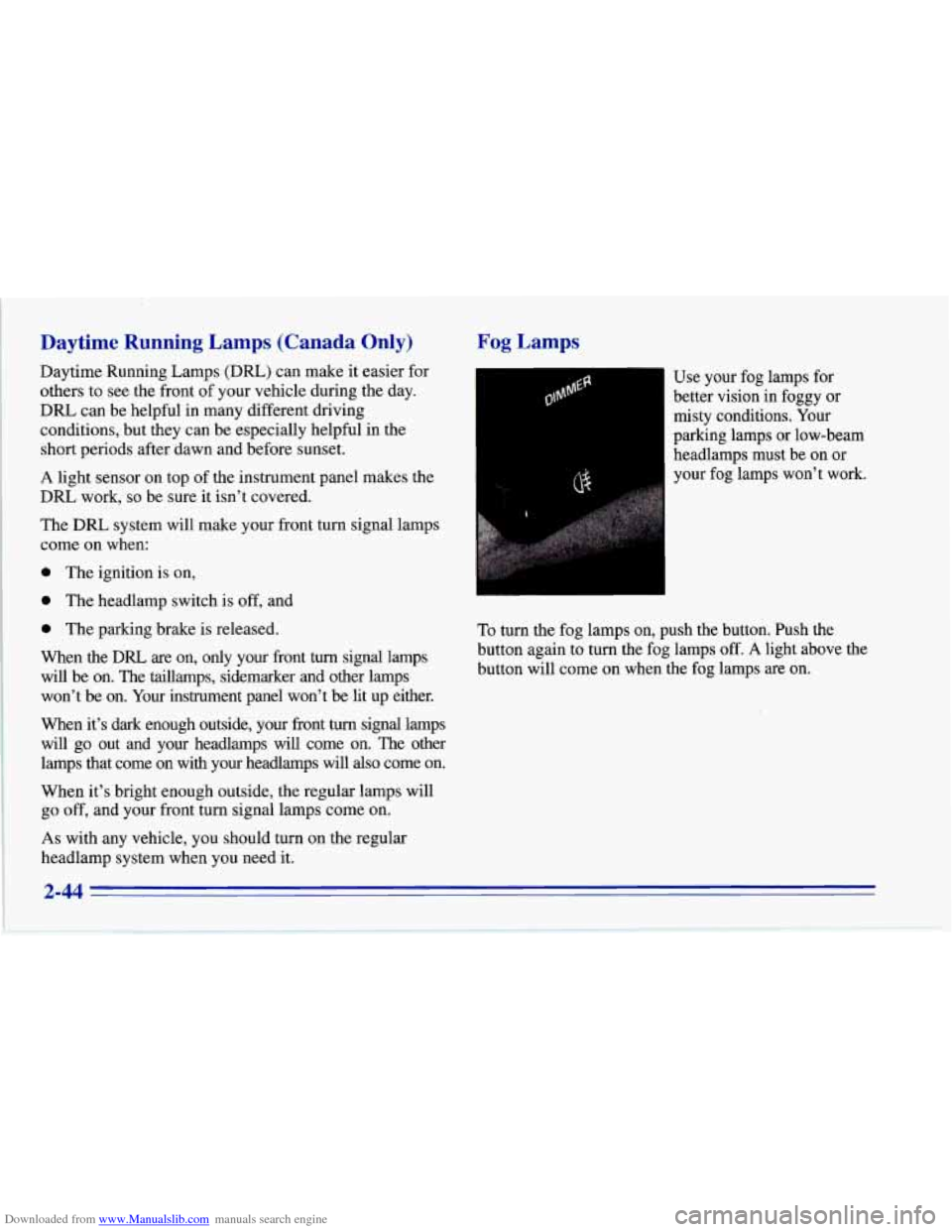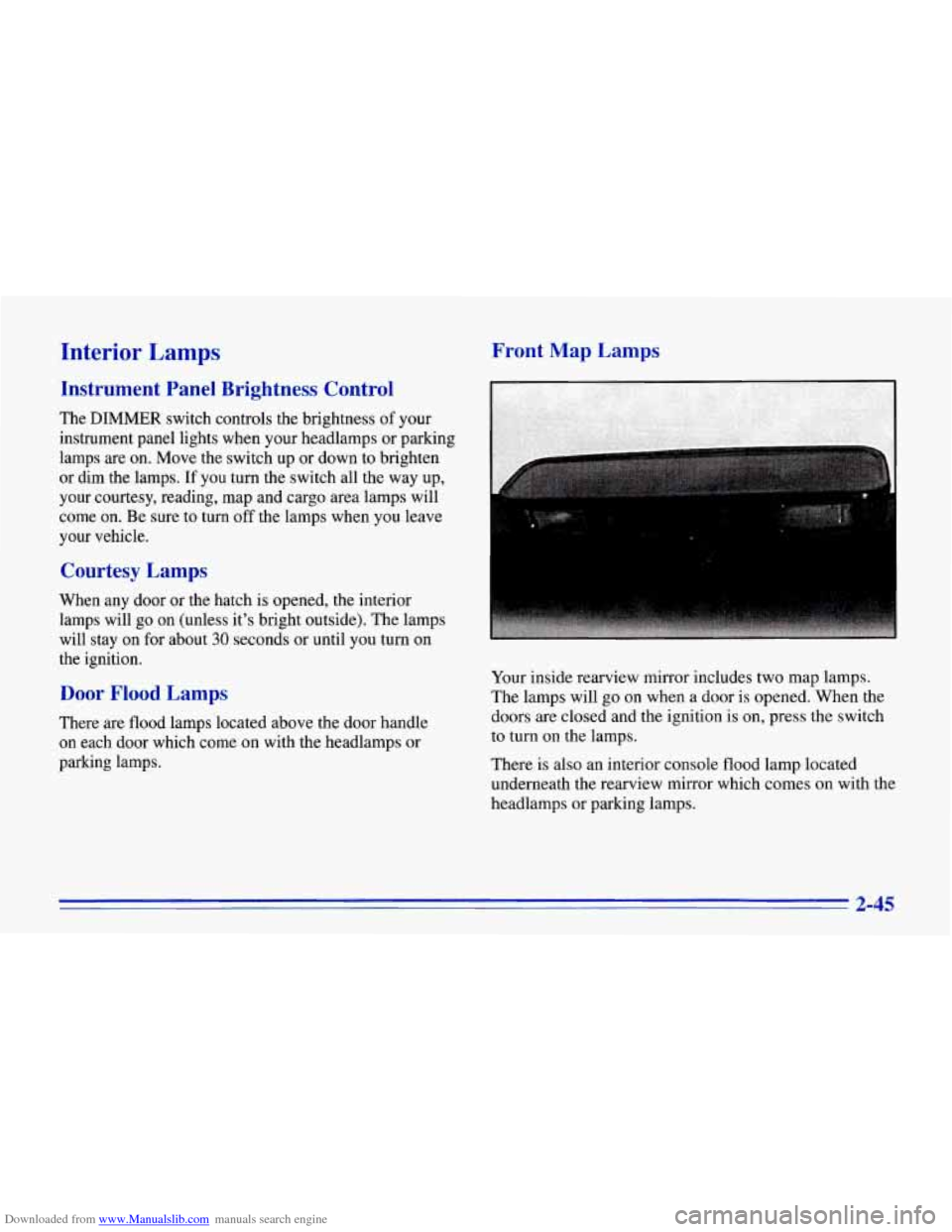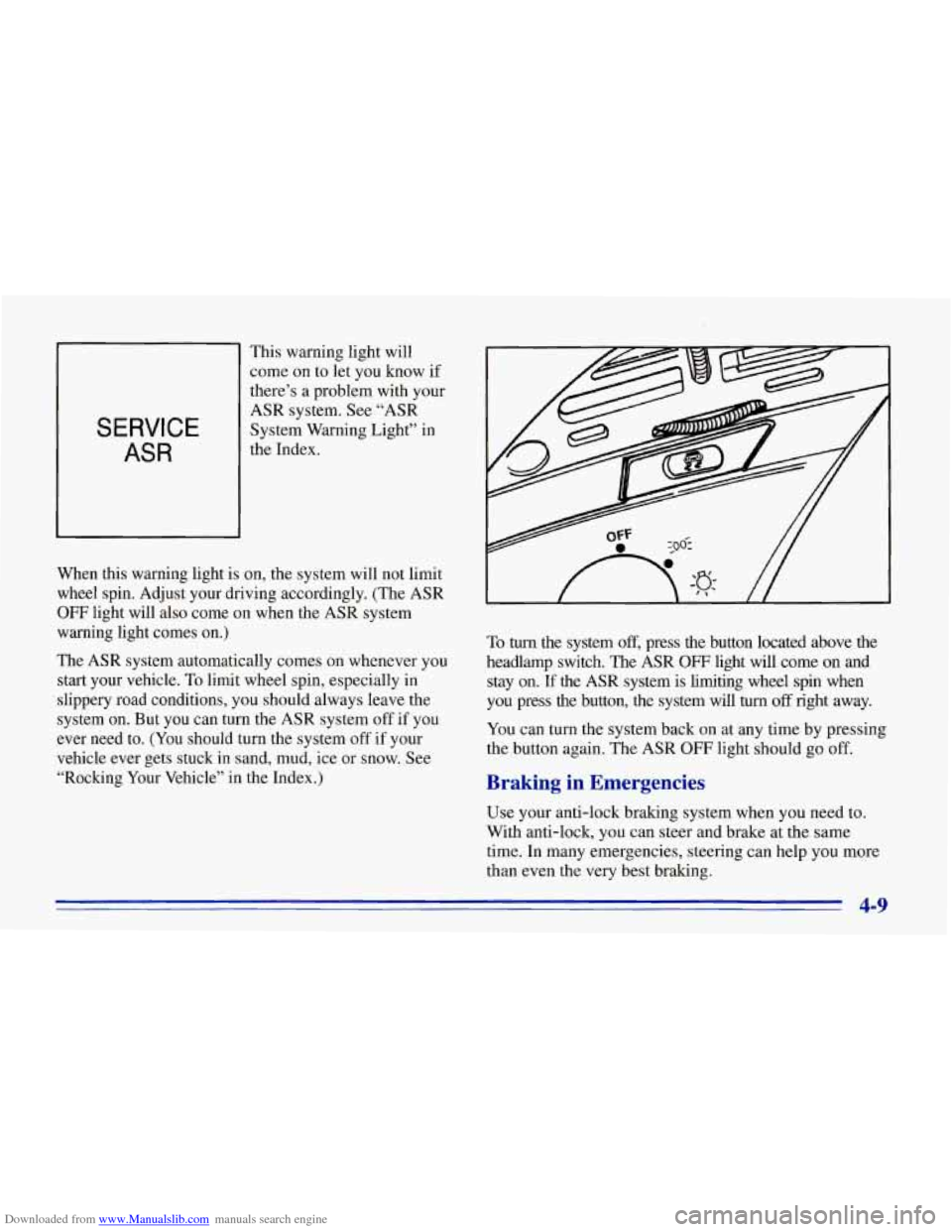Page 5 of 386
Downloaded from www.Manualslib.com manuals search engine L;
In 1963, Corvette hit the road with an eye-catching new
look
-- the Sting Ray coupe. An instant success, the
now-classic Sting Ray featured concealed headlamps
and
a unique split rear window. The split window would
only be offered in
1963, making this model among the
most prized Corvettes ever built.
Restyled inside and out for
1968, this 'Vette sported a
lean and hungry shape, creating a sense of motion even
when standing still. And for the first time, Corvette
offered removable roof panels.
iv
Page 78 of 386
Downloaded from www.Manualslib.com manuals search engine Tilt Wheel
A tilt wheel allows you to adjust the steering wheel
before you drive.
You can also raise it to the highest level to give your
legs more
room when you exit and enter the vehicle,
To tilt the wheel, hold the steering wheel and pull the
lever toward you. Move the steering wheel to a
comfortable level, then release the lever to lock the
wheel in place.
Turn SignaYMultifunction Lever
The multifunction lever on the left side of the steering
column includes your:
0 Turn Signal and Lane Change Indicator
Headlamp HighLow Beam Changer
Windshield Wipers
0 Windshield Washer
0 Cruise Control
2-35
Page 79 of 386

Downloaded from www.Manualslib.com manuals search engine nrn and Lane Change Signals
The turn signal has two upward (for right) and two
downward (for left) positions. These positions allow you
to signal a turn or a lane change.
To signal a turn, move the multifunction lever all the
way up or down. When the turn is finished,
the lever
will return automatically.
A chime will remind you if you leave your turn signal
on for more than
1 mile (1.6 km) of driving.
An arrow on the instrument
panel will flash in the
direction of the turn or lane
change.
To signal a lane change, just raise or lower the lever
until the
arrow starts to flash. Hold it there until you
complete your lane change. The lever will return by
itself when you release it.
As you signal a turn or a lane change, if the arrows don’t
flash but just stay on, a signal bulb may be burned out
and other drivers won’t see your turn signal.
If a bulb is burned out, replace it to help avoid an
accident.
If the arrows don’t go on at all when you
signal a turn, check for burned-out bulbs and check the
fuse (see “Fuses and Circuit Breakers” in the Index).
Headlamp High/Low Beam Changer
To change the headlamps
from low beam to high or
high to low, pull the turn
signal lever all the way
toward you. Then release it.
When the high beams
are
on, this light on the
instrument panel also
will be on.
Page 85 of 386
Downloaded from www.Manualslib.com manuals search engine Lamps
Headlamps
The headlamp knob controls these lamps:
0 Headlamps
Taillamps -
0 Parking lamps
Sidemarker lamps
-g- Turn the knob to this symbol to turn on your
headlamps and other operating lamps.
Turn the knob to this symbol to turn on your
parking and other operating lamps without your
headlamps.
Turn the knob to
OFF to turn off the lamps.
Your digital display will dim at dusk to remind you'to
turn on your headlamps.
To read your odometer and fuel level with the ignition
off, turn on your parking lamps. ,
Page 86 of 386
Downloaded from www.Manualslib.com manuals search engine Headlamp Doors
The headlamp doors are designed to open when you
turn the headlamps on, and close when you turn the
headlamps and parking lamps off.
If you turn the
headlamps on, then turn the headlamp switch back to
the parking lamps setting, the headlamp doors will
stay open. You
can open the doors manually using the knob next to
the headlamp assembly. Turn the knob counterclockwise
until the doors are open.
The headlamp doors should be open when driving in icy
or snowy conditions to prevent the doors from freezing
closed and when washing the vehicle to help clean the
headlamps
.
Lamps On Reminder
If you turn the ignition off and leave the headlamps or
parking lamps on, you will hear a chime.
2-43
Page 87 of 386

Downloaded from www.Manualslib.com manuals search engine Daytime Running Lamps (Canada Only)
Daytime Running Lamps (Dm) can make it easier for
others to see the front of your vehicle during the day.
DRL can be helpful in many different driving
conditions, but they can be especially helpful in the
short periods after dawn and before sunset.
A light sensor on top of the instrument panel makes the
DRL work,
so be sure it isn’t covered.
The DlU system will make your front turn signal lamps
come on when:
0 The ignition is on,
0 The headlamp switch is off, and
0 The parking brake is released.
When
the DRL are on, only your front turn signal lamps
will be on. The taillamps, sidemarker and other lamps won’t be on. Your instrument panel won’t
be lit up either.
When it’s dark enough outside, your front
turn signal lamps
will go out and your headlamps will come on. The other
lamps that come on with your headlamps will
also come on.
When it’s bright enough outside, the regular lamps will
go
off, and your front turn signal lamps come on.
As with any vehicle, you should turn on the regular
headlamp system when you need it.
Fog Lamps
I-1 Use your fog lamps for
better vision in foggy or
misty conditions. Your
parking lamps or low-beam
headlamps must be on or
your fog lamps won’t work.
To turn the fog lamps on, push the button. Push the
button again to turn the fog lamps
off. A light above the
button will come on when the fog lamps are on.
2-44
Page 88 of 386

Downloaded from www.Manualslib.com manuals search engine Interior Lamps
Instrument Panel Brightness Control
The DIMMER switch controls the brightness of your
instrument panel lights when your headlamps or parking
lamps are on. Move the switch up or down to brighten
or dim the lamps.
If you turn the switch all the way up,
your courtesy, reading, map and cargo area lamps will
come on. Be sure to turn
off the lamps when you leave
your vehicle.
Courtesy Lamps
When any door or the hatch is opened, the interior
lamps will go on (unless it's bright outside). The lamps
will stay on for about
30 seconds or until you turn on
the ignition.
Door Flood Lamps
There are flood lamps located above the door handle
on each door which come on with the headlamps or
parking lamps.
Front Map Lamps
.. .. .. .. . '
Your inside rearview mirror includes two map lamps.
The lamps will go on when a door
is opened. When the
doors are closed and the ignition is on, press the switch
to turn
on the lamps.
There is also an interior console flood lamp located
underneath the rearview mirror which comes on with the
headlamps or parking lamps.
2-45
Page 170 of 386

Downloaded from www.Manualslib.com manuals search engine SERVICE
ASR
This warning light will
come on to let you know if
there’s a problem with your
ASR system. See “ASR
System Warning Light” in
the Index.
When this warning light is on, the system will not limit
wheel spin. Adjust your driving accordingly. (The ASR
OFF light will also come on when the ASR system
warning light comes on.)
The ASR system automatically comes on whenever you
start your vehicle.
To limit wheel spin, especially in
I slippery road conditions, you should always leave the
system on. But you can
turn the ASR system off if you
ever need to. (You should turn the system off if your
vehicle ever gets stuck in sand, mud, ice or snow. See
“Rocking Your Vehicle” in the Index.) To
turn the system off, press the button located
above-the
headlamp switch. The ASR
OFF light will come on and
stay on.
If the ASR system is limiting wheel spin when
you press the button,
the system will turn off right away.
You can turn the system back on at any time by pressing
the button again. The ASR
OFF light should go off.
Braking in Emergencies
Use your anti-lock braking system when you need to.
With anti-lock, you can steer and brake at the same
time. In many emergencies, steering can help you more
than even the very best braking.
4-9